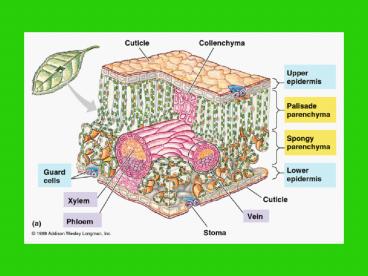Light Reaction of Photosynthesis - PowerPoint PPT Presentation
1 / 38
Title:
Light Reaction of Photosynthesis
Description:
Title: No Slide Title Author: OCSD Last modified by: OCSD Created Date: 10/12/2001 4:08:51 PM Document presentation format: On-screen Show Company – PowerPoint PPT presentation
Number of Views:106
Avg rating:3.0/5.0
Title: Light Reaction of Photosynthesis
1
(No Transcript)
2
Light Reaction of Photosynthesis
3
- occurs in thylakoid (stacks of paper
plates) - thylakoids found in chloroplast
4
Light enters and is absorbed by photosystem II
H2O
Light
LIGHT REACTIONS
ATP
NADPH
Chloroplast
O2
5
- Photosystem II
- consist of pigments, proteins, and organic
molecules.
act as antennas that absorb light energy
6
- Photosystem II
- Photon energy is transferred from pigment to
pigment until it reaches
chlorophyll a
7
(No Transcript)
8
(No Transcript)
9
in chlorophyll a
CH3
P I G M E N T
in chlorophyll b
CHO
Porphyrin ring light-absorbing head of
molecule note magnesium atom at center
Hydrocarbon tail interacts with
hydrophobic regions of proteins inside thylakoid
membranes of chloroplasts H atoms not shown
10
Fills in lost e- from H20 being split
11
(No Transcript)
12
to the
13
Photosystem II
- Photo II aka. P680- absorbs wavelengths of light
at 680nm
14
- Light Reaction overview
- 1)pigments absorb light photon the photon is
relayed around photo II - 2) an e-, from chlorophyll a bounces to the next
energy level caught by the primary e- acceptor
Solar E. --gt Chemical E.
15
H2O
CO2
Light
NADP
CALVIN CYCLE
LIGHT REACTIONS
NADPH
CH2O (sugar)
O2
Primary acceptor
e
Light
P680
Photosystem II (PS II)
16
- Light Reaction overview
- 3)meanwhile an enzyme splits H2O -gt H, e-, O
- an e- fills in the e- lost by the P680
molecule - O2 goes up your nose
Solar E. --gt Chemical E.
17
H2O
CO2
Light
NADP
CALVIN CYCLE
LIGHT REACTIONS
NADPH
O2
CH2O (sugar)
Primary acceptor
e
H2O
2 H
O2
1/2
Energy of electrons
Light
P680
Photosystem II (PS II)
18
- Light Reaction overview
- 4)Each photexcited e- is now passed down an e-
transport chain - 5) The e- fall synthesizes ATP (H
gradient from H20 splitting)
Solar E. --gt Chemical E.
19
H2O
CO2
Light
NADP
CALVIN CYCLE
LIGHT REACTIONS
ATP
H
H
H
H
O2
CH2O (sugar)
H
H
Primary acceptor
H
Electron transport chain
Pq
H
H2O
e
Cytochrome complex
2 H
O2
Pc
Energy of electrons
Light
P680
ATP
Photosystem II (PS II)
20
- Light Reaction overview
- 6) chlorophyll in PS I absorbs light photon the
photon is relayed - an e- is bounced to the next energy level
caught by the Primary e- acceptor
Solar E. --gt Chemical E.
21
Photosystem I and II what makes them different?
- Photo II aka. P680- absorbs wavelengths of light
at 680nm
Photo I aka. P700- absorbs wavelengths of light
at 700nm
22
H2O
CO2
Light
NADP
CALVIN CYCLE
LIGHT REACTIONS
NADPH
CH2O (sugar)
Primary acceptor
Primary acceptor
Electron transport chain
Pq
e
e
H2O
Cytochrome complex
2 H
O2
1/2
Pc
P700
Light
P680
Light
ATP
Photosystem I (PS I)
Photosystem II (PS II)
23
- FYI
- P680 and P700 are identical chlorophyll a
molecules. - difference in light absorption comes from
association with different proteins in the
thylakoid membrane.
24
- Light Reaction overview
- 7) e-s passed down the second chain
- 8) 2 e-s hop on an NADP bus and form NADPH
Solar E. --gt Chemical E.
25
NADPH
off to the dark side
26
- Photophosphorylation - Light energy
generates ATP
27
2 H
2 H
2 H
2 H
2 H
2 H
2 H
2 H
2 H
2 H
2 H
2 H
28
- Purpose of Light Reactions (revisited)
- Generate ATP
- Generate NADPH
- these will provide E. reducing power to the
Calvin Cycle.
29
Light Reaction
30
e- carrier
31
e- carrier
32
via. ATP synthase
33
e
ATP
e
e
NADPH
e
e
e
Mill makes ATP
Photon
e
Photon
Photosystem II
Photosystem I
34
Go to the dark side
35
- Cyclic Electron Flow-
- occurs under condition where there is not enough
ATP for Calvin Cycle.
- Uses photosystem I but not II.
- No production of NADPH
- No production of O2
36
- Cyclic Electron Flow-
- Rise in NADPH (b/c Calvin Cycle consumes more
ATP) - triggers this process, goal to make ATP catch
up with NADPH. - Side steps Photo II (P680).
37
Primary acceptor
Fd
Cytochrome complex
Pc
Photosystem I
ATP
38
- Cyclic Electron Flow-
- Excited electrons from Photo I are passed by
electron acceptor to Fd (ferrodoxin). - Then passed to ETC to make ATP .
- No NADPH is made and there is no release of O2.































